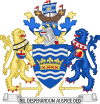Washington Old Hall
| Washington Old Hall | |
|---|---|
 Main entrance of the Washington Old Hall | |
| General information | |
| Status | Used as a museum |
| Address | The Avenue, Washington Village |
| Town or city | Washington, Tyne and Wear |
| Country | England |
| Coordinates | 54°54′09.86″N 1°30′59.17″W / 54.9027389°N 1.5164361°W |
| Construction started | c. 1183 |
| Completed | 17th century |
| Client | William de Hertburn |
| Owner | National Trust |
| Technical details | |
| Material | Stone |
| Website | |
| Washington Old Hall | |
Washington Old Hall is a historic manor house in Washington, Tyne and Wear, England. It lies in the centre of Washington, being surrounded by other villages. The building was the ancestral home of the family of George Washington (1732–1799), the first president of the United States.
History
[edit]
William de Hertburne (originally William Bayard),[1] an ancestor of George Washington, assumed tenancy of the Wessyngtonlands from the Bishop of Durham in the late 12th century. Soon after, he changed his name to William de Wessyngton (later Washington).[2] In the early 15th century Sir William Mallory married Dionysia Tempest, the last Wessyngton heir at the Hall. Dionysia was daughter of Sir William Tempest and his cousin, Eleanor Wessyngton. In 1613, Sir John Mallory (a descendant of Sir William Mallory and Dionysia Tempest) and Anna Eure, shareholders in the Virginia Company, moved south to Sulgrave Manor in Northamptonshire, and the manor was sold to the Bishop of Durham.[3]
The Hall continued to be used as a residence until the 19th century, when it became tenement flats and gradually fell into disrepair. In 1936 the building was declared unfit for human habitation, and was rescued from demolition by Fred Hill, a local teacher, who created what is now the "Friends of the Old Hall" to press for restoration of the building. Restoration began in 1937.[4] Preservation work stopped during World War II, but was completed in 1955. The building was opened by the American Ambassador, Winthrop W. Aldrich.[5] In 1957, the National Trust assumed responsibility for the building.[6]
As a result of these historic ties, in 2007, Washington, D.C., and the City of Sunderland announced a "friendship agreement," hoping to create cultural and economic ties with one another.[7]
References
[edit]- ^ Wells, William C. (1913). "A Washington Token" (PDF). British Numismatic Journal. 2. 10. British Numismatic Society: 326.
- ^ "Washington Old Hall". Newcastle Gateshead. Retrieved 4 April 2015.
- ^ "The story of Washington Old Hall's thousand year history – and its American connection". Sunderland Echo. 6 July 2020. Retrieved 3 December 2020.
- ^ Historic England. "Washington Old Hall, Sunderland (1354971)". National Heritage List for England. Retrieved 3 December 2020.
- ^ "Washington Old Hall". BBC. Retrieved 3 December 2020.
- ^ "Sunderland City Council information leaflet" (PDF). Archived from the original (PDF) on 27 September 2007. Retrieved 19 February 2007.
- ^ "Students seal 'friendship' pact". BBC. 17 September 2007. Retrieved 3 December 2020.
Further reading
[edit]- Alexander, Lawrence (September 2021). "Washington Old Hall". Hidden Gems. Britain. Vol. 89, no. 4. London: The Chelsea Magazine Company. p. 82. ISSN 1757-9732.
- Margot Johnson. "Washington Old Hall" in Durham: Historic and University City and surrounding area. Sixth Edition. Turnstone Ventures. 1992. ISBN 094610509X. Page 40.
External links
[edit] Media related to Washington Old Hall at Wikimedia Commons
Media related to Washington Old Hall at Wikimedia Commons- Official website

- 1180s establishments in England
- Grade I listed buildings in Tyne and Wear
- Historic house museums in Tyne and Wear
- Houses completed in the 17th century
- Manor houses in England
- Museums in the City of Sunderland
- National Trust properties in Tyne and Wear
- Hall houses
- Rebuilt buildings and structures in the United Kingdom
- Stone houses
- Washington family residences
- Washington, Tyne and Wear



